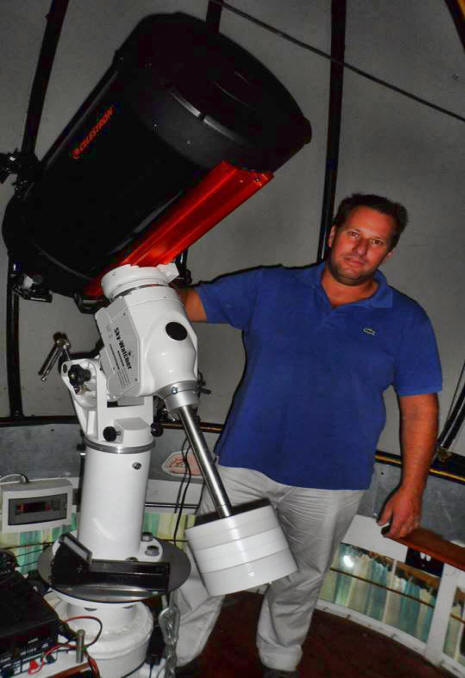Νight observation
The
Observatory Hipparchos of Rhodes focuses on the observation of the moon, the
planets and the sun. Beneath the 2.5m and 4m diameter domes are installed a
XLT CELESTRON 11" (300mm)
focal length F2800 mm with a focal ratio f/10 telescope on a
equatorial mount EQ6 and an MEADE LX200 14'' F10 with diameter of 35 cm and
focal length 3500mm with a focal ratio f/10 telescope on a Fork mount . We offer visitors a memorable tour of the beautiful sky of
Rhodes-Greece. On hot summer evenings we make observation in the stargarden with
the following instruments. A refractor Skywatcher 120 ProSeries diameter 120mm
and 650mm focal length with a focal ratio f/7.5 mounted telescope on equatorial
mount and a large 40kg Dobson type focal length F1500 mm with a focal ratio f/5F
telescope. We also available a small telescope or binoculars for rent.
For the observation of the moon we use ND filters. The observatory is equipped
with wireless internet and astronomical planetarium programs such as Celestia,
Stellarium, observational astronomy becomes interesting in theory but
particularly in practice. The observatory has eyepieces with diameter lenses 1¼
" and 2" with different focal lengths from 5mm to 50mm for various
magnifications and additional magnifier type Barlow 1,5X and 3X. Measurements
made by SQM in the area for the quality of the night starry sky showed values is
19,5 - 20 magnitude (mag / arc sec²).
Observation of photosphere at 540nm ( green).
In a specially designed dark room for solar observations there are two solar telescopes with which the visitor can observe the solar disk. The solar refractor open- Fraunhofer airspace focal length 1500mm and 105mm diameter is equipped with a 2" prism Hershel filter Continuum at 540nm (green). With the help of long focal length of the instrument is extremely easy to observe formations of spot groups, shadows, the penumbra and the torches. Furthermore there is the option to view the solar image on projection screen (monitor) with a diameter of 100 centimeters . Solar telescopes have focused type crayford with steel runners and decimal division for precision focus.
Chromosphere
observation. (red)
Filter hydrogen (Ha) in 656,3nm with Front Etalon D = 60mm and BF10
http://www.astronomy.gr/main.cfm?module=article&id=1208&action=detail
With refractor ED80 Pro-Series diameter and 80mm focal
length F600mm with focal ratio f/7.5 in combination with hydrogen filter Ha
Front Etalon D = 60mm and BF10 in 656,28nm, we are able to see the chromospheres
(the solar atmosphere). Rapid changes in the chromosphere, (within a period of
even a few minutes), give us the opportunity to see extensive formations
explosive projections (jets of glowing hydrogen with dimensions exceeding
sometimes and 500,000 km !!!) and solar flares that are extremely violent
phenomenon that occurs in the solar chromosphere. With the help of the regulator
(tuner) hydrogen filter we can see the deeper layers of the atmosphere of the
sun. The impressive chromospheric phenomena are rapidly evolving and are
perceived observing within minutes. Sun spots, torches, projections and flares
can be observed almost daily (weather permitting) through the optics but also
through CCD camera and monitor. It is also possible from the visitor to take
pictures.
Ouranostatis – Heliostat – Celeostat - tracker
The horizontal tracker - double reflection Heliostat (and
double mirrors) sends sunlight to fully darkened room for solar observation, at
the installed solar instruments. Handling and driving the tracker is made from
the solar observation room. With 4 flat mirrors made from Zerodur with a
diameter of 4"(102mm) and flatness of lambda λ/10 mounted on a tracker.
Due to the blackout during ophthalmoscopic observation, contrast is excellent
with complete absence of disturbing diffused daylight. Visitors have an
excellent image with high resolution when observing the solar disk. Solar
telescopes are mounted horizontally on the solar bank and offer a comfortable
observation without light reflections.
Solar protection.
Solar telescopes are equipped with protective filters radiation type IR/UV cut
for safe and convenient solar observation.
Observing the sunlight with the spectrograph - spectroscope
Although it is relatively rare for someone to
observe the sunlight through a spectrograph, we however in amateur observatory
of Rhodes Hipparchos allow guests to observe the analysis of sunlight with a
high-resolution spectrograph (reflective barrier 1200 lines / mm 12,32Å / mm).
The observer will notice the solar spectrum dotted by hundreds Fraunhofer
absorption lines with a backdrop of breathtaking colors of the iris (the
rainbow!!). Besides ophthalmoscopic observation, we can add a camera for
photographing the solar spectrum.
Acknowledgements to:
Mr. Volker Milde for his valuable advice in organizing and setting up the
observatory.
Mr. Aristides Voulgaris for the construction and technical support of the solar
observatory.
Also Astronomy & Space Volos Company and everyone who worked together to create
and promote our website.
We welcome you to the amateur observatory Rhodes Hipparchos for an experience of
observational astronomy.


